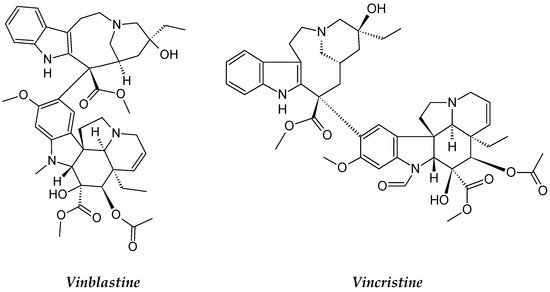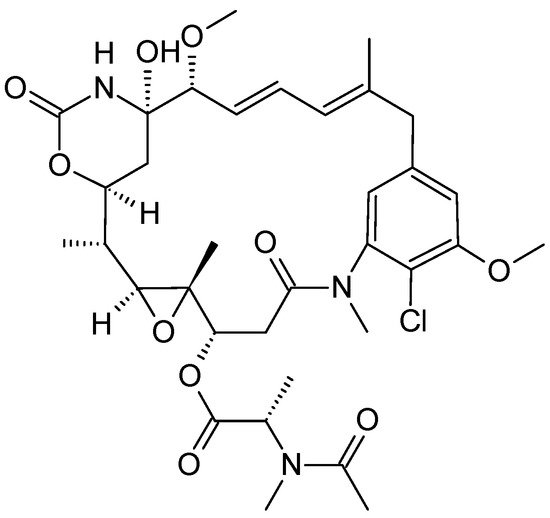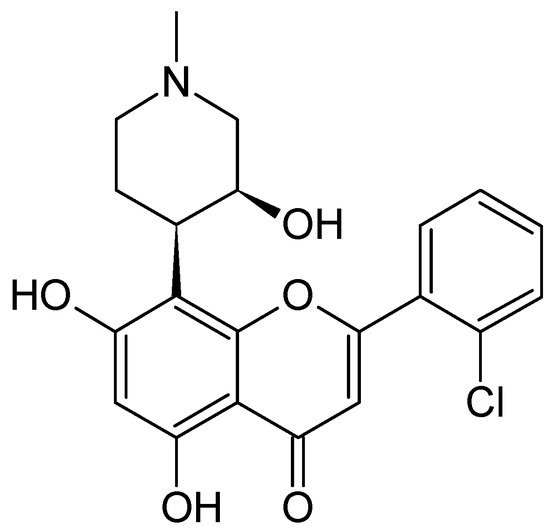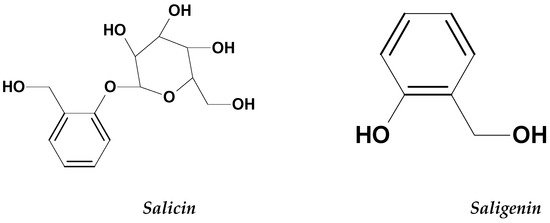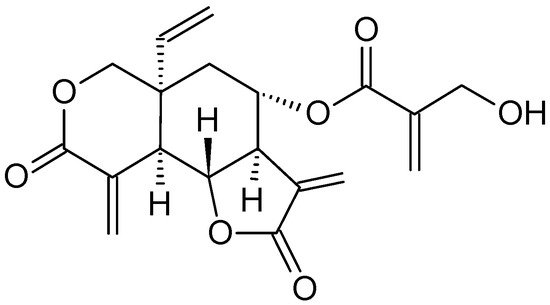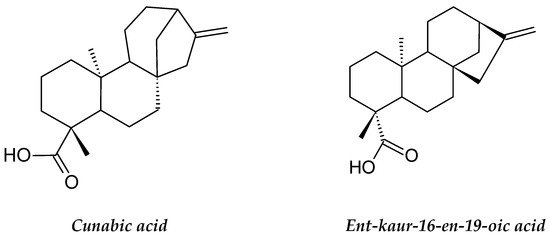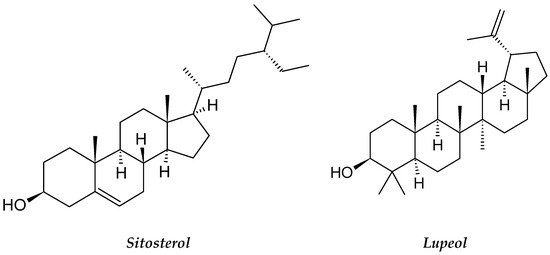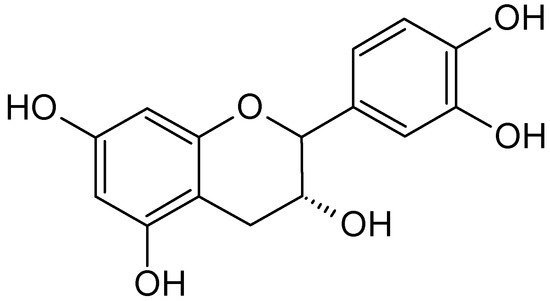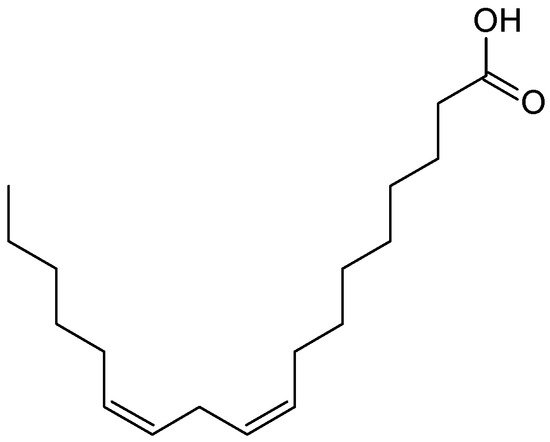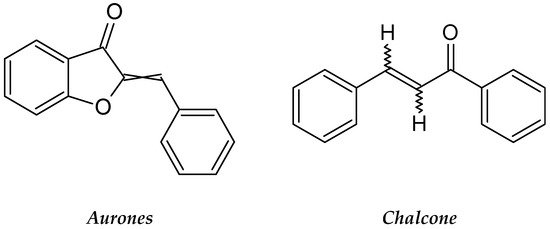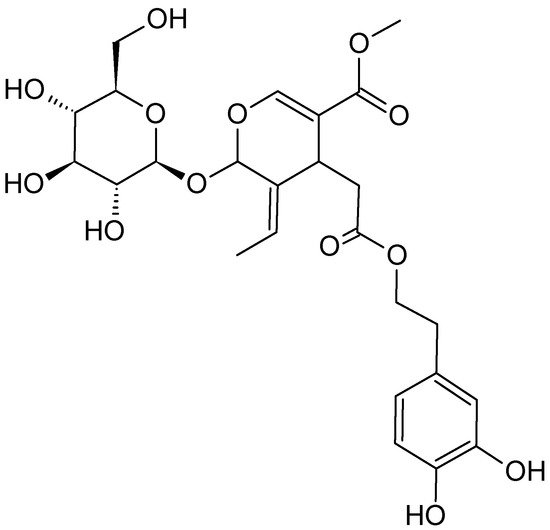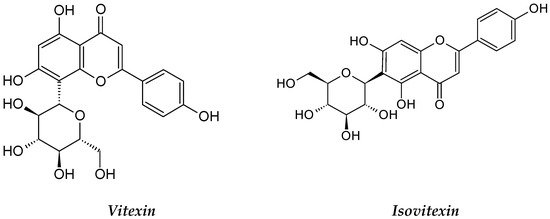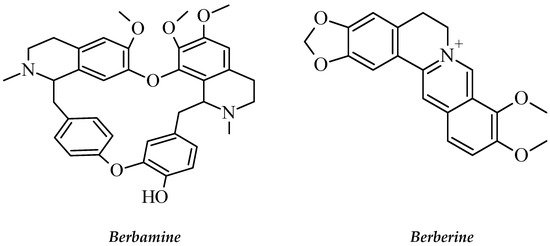Many ethnomedicinal plants have been recommended to treat leukemic disease in the conventional medicine system [16]. Conventional medicine pursues the use of natural ingredients, thereby offering reinforcements to the cell regularly to revitalize the normal cell for cancer therapy [17]. This review article elaborates different species of plants which have great potential for combating leukemia. The compounds in this review include plant-derived anti-leukemic compounds clinically used as treatments, and others being examined in clinical and pre-clinical studies.
In this section, we review several traditional medicinal plants that have established clinical uses for the treatment of leukemia.
2.3. Medicinal Plants in Pre-Clinical Investigations (In Vitro) for Leukemia
In this section, we highlight various medicinal plants that are in preclinical investigations (in vitro) for the treatment of leukemia.
2.3.1. Salix Genus (Willows)
Willows belongs to the Salicaceae family and
Salix genus, which contains about 400 species. It is also called osiers and sallows [
48] depending on the shape of the leaves. Species with narrower lance-shaped leaves are known as osiers, and those with rounder lance-shaped leaves are known as sallows. Willows are native to cold temperate regions of the Northern Hemisphere. Their leaves and bark have been utilized in treating fevers and as a remedy for pain relief. Its pain relief effect has been studied scientifically, and the bioactive compound salicin () was found to be responsible for it [
49,
50].
Figure 5. The structures of salicin and saligenin.
Willow leaves have also been tested and evaluated for anti-leukemia activity. The aqueous extract from willow leaves has been reported to have high activity against ALL and AML cells. The extract prevented proliferation by inducing apoptosis and causing DNA fragmentation within both types of tumor cells [
51]. The leaf extract is also toxic toward human leukemia 60 (HL-60) and significantly reduced the viability of the HL-60 cells in a time and dose-dependent manner [
49]. The extract induced toxicity towards HL-60 cells by increasing the p53 expression in the tumor, initiating cell cycle arrest at G2M and decreasing cell division [
51]. Salicin and saligenin () found in the leaf extract killed HL-60 cells by damaging some proteins and enzymes [
49]. The anti-leukemic effects of the willow extract are also probably related to salicylic acid derivatives, phenols, flavonoids, proanthocyanidins and total tannins that are found in the extract [
48].
2.3.2. Vernonia amygdalina
Vernonia amygdalina belongs to the Compositae family and is commonly called an African medicinal plant [
52]. The plant is original to Nigeria (West Africa) and is widely distributed in the African countries, especially in South Africa (including Eastern Cape, Mpumalanga and KwaZulu Natal) [
52]. The plants usually grow in the western part of Sudan during the summer and can also be found in Asia, particularly in Singapore and Malaysia. It is the largest plant used in the genus of
Vernonia and commonly used to treat gastrointestinal problems, wounds, hepatitis and diabetes [
52].
Vernonia genus is the best source of sesquiterpene lactone compounds that have been stated to be cytotoxic and anticancer [
53].
In vitro testing of
V. amygdalina root extract showed that it possessed significant antiproliferative activity and killed the majority (50–75%) of ALL and AML leukemic cells [
1]. Vernodaline and vernolide () are sesquiterpene lactones that are commonly found in the root extract of
V. amygdalina; they play a significant role in killing abnormal leukemic cells by promoting cell apoptosis [
1,
52]. A cytotoxicity study of
V. amygdalina leaf extract showed that the extract prevents the proliferation of two cancer cell types, AML and ALL [
54]. Another study observed remarkable destruction of lymphoblasts after treating mononuclear ALL cells with
V. amygdalina extract for 24 h [
1].
Figure 6. The structure of vernodalin.
It has been reported that the ethanol extract of
V. amygdalina contains phenolic and falconoid compounds, glycosides and many types of tannin. Due to this,
V. amygdalina extract used alone or mixed with other extracts or drugs has the ability to selectively fight the leukemic cells [
1]. Therefore,
V. amygdalina extracts could constitute low-cost cancer therapy after safety and efficacy studies, and lead to drug-resistant cancer treatments [
55].
2.3.3. Nyctanthes arbor-tristis
Nyctanthes arbor-tristis is also known as night-flowering jasmine. It is a wild shrub-flourishing plant (Family: Oleaceae) [
56], and popular medicine in India, West Bengal and Sri Lanka [
56].
N. arbor-tristis has been tested by scientists for anti-inflammatory, antioxidant, antidepressant, antiviral, analgesic, anthelmintic, antihistaminic, amoebicidal, antipyretic and anticancer activities [
57,
58].
It was reported that the cytotoxic activity of seed extracts on CEM and CEM/VLB cells is through cyclin kinase protein up-regulation (WAF1/p21) and cell cycle blockage at G0/G1 phase, resulting in cancer cell death [
59]. Flow cytometric analysis of
N. abor-tristis extract-treated cells showed that the seed extracts caused sub-G0 and G0/G1 phase arrest. Recently,
N. abor-tristis flower aqueous extract has been demonstrated to potently inhibit the cell proliferation of the human T l ymphocyte cell line [
60]. The flower extract has also shown cytotoxicity against CML K562 in a dose-dependent manner and caused significant cell death in resistant and sensitive human cancer cell lines [
57]. These properties induced by the plant extract are probably because of the presence of various types of phytochemicals, including phenols, tannins, steroids and glycosides. These phytochemicals are projected to be responsible for the antitumor activity [
57,
58]. The crude extract of
N. abor-tristis, and pure compounds such as arbortristoside A, hydroxy hexahydrobenzofuran-one and β-hydroxyloganin that were isolated from the plant seeds, along with a polysaccharide from the leaves and naringenin from the stems, have been reported to possess antioxidant and anticancer properties [
60,
61]. Due to this, the water extract of
N. abor-tristis flowers should be further investigated as a neutral medicine to stop leukemia and to be mixed with other therapeutic drugs.
2.3.4. Annona glabra
Annona glabra L., known as the pond apple, belongs to the Annonaceae family [
62]. It is a tropical wild tree native to Asia and the Americas that has been used in traditional Chinese medicine. Its phytochemical constituents, such as acetogenins; diterpenoids like cunabic acid and Ent-kaurenoic acid (); and alkaloids, have been shown to exhibit antimalarial, anti-HIV and anticancer properties [
62,
63].
Figure 7. The structures of cunabic acid and Ent-kaur-16-en-19-oic acid.
The anti-tumor activity of
A. glabra was tested by using the alcoholic extracts of the leaves, pulp and seeds on leukemia cell lines [
62]. The study reported that the seed extract of
A. glabra was more effective than pulp and leaf extracts against multidrug-resistant leukemia (CEM/VLB) and drug-sensitive leukemia (CEM) cells. These findings support the traditional utilization of the alcoholic seed extract of
A. glabra as a rich source of antitumor drugs. The methanolic extract from
A. glabra fruits also showed a potent effect against HL-60 cells by cell cycle arrest at the G1 phase [
62]. In HL-60 cells,
A. glabra fruit extract was seen to negatively affect Bcl-2 and Bax proteins, and cleaved caspase-3 and PARP to induce cancer cell death. The fruit extract also stimulated apoptosis by reducing AKT phosphorylation and down-regulating c-myc protein [
63]. Besides, Liu et al. [
64] found that leaf extracts of
A. glabra at high concentrations inhibited leukemia cell colony formation and caused more leukemia cells to become apoptotic. Leaf extracts of
A. glabra reduced the migratory potential of leukemia cells as well. In vitro biochemical investigations on the treated-leukemia cells showed that the leaf extract also stimulated the activity of free radical scavenging and ROS and reduced ATP synthesis [
64].
Screening of the phytochemical constituents of the ethanolic extracts of
A. glabra leaves showed that the plant leaves contain terpenoids, flavonoids, saponins, glycosides, anthraquinones, steroids, tannins and acidic compounds, and do not contain alkaloids, phlobatanin or reducing sugars [
64]. The methanolic extracts of
A. glabra fruit contain dihydrophaseic acid β-d-glucopyranoside, dihydroxybenzoic acid, dimethoxyphenyl β-d-glucopyranoside, icariside D2-d-xylopyranoside, cucumegastigmane I, blumenol A and icariside B1. Among the compounds found in
A. glabra fruit, the one responsible for the cytotoxic effect on HL-60 cell line is icariside D2 [
62]. Indisputably, based on the results above, the anticancer potential of
A. glabra extracts is strong, validating its complementary and alternative medicinal uses.
2.3.5. Basella alba
Basella alba is a wildly cultivated, cool-season vegetable categorized under the family of Basellaceae [
65].
B. alba is known as vine spinach, Chinese spinach, Indian spinach, Malabar spinach and Ceylon spinach [
65].
B. alba is native to Malaysia, India, the Philippines, Indonesia, tropical Africa, tropical and South America, Southeast of Brazil and the Caribbean. India and China are the two major countries utilizing the plant for its medicinal benefits [
66]. In India, the Ayurvedic treatment uses
B. alba leaves against oral cancer, leukemia and melanoma [
66]. The plant was reported for its anticonvulsant, anti-inflammatory and antifungal activities, and as an analgesic, an anemia treatment and an androgenic therapy [
67,
68].
B. alba contains various bioactive phytoconstituents with proven cytotoxic, antioxidant, hemagglutinating and antiproliferative effects on cancer cells [
69]. The
B. alba leaf and seed extracts have different phytoconstituents, such as phenols, flavonoids, saponins, alkaloids, tannins, steroids and phytosterols [
70]. The plant also has many important phytochemicals, including betacyanins, carotenoids, triterpene oligoglycosides, various organic acids, basellasapoins A–D, kaempferol and betalin [
71]. A different study showed that the methanolic plant extract contained β-sitosterol and lupeol (), which were found to be cytotoxic to lung cancer cells and leukemia cells [
72]. The methanolic leaf extract of
B. alba displayed significant growth inhibition of U937 leukemic cells in a dose-dependent manner [
73].
Figure 8. The structures of sitosterol and lupeol.
2.3.6. Ferulago angulata
Ferulago angulata also known as chovir is a Persian medicinal herb, a common plant found in Iran, Iraq, Turkey, Serbia, Greece and Macedonia [
74].
F. angulata is from the Apiaceae family, and many
Ferulago species have traditionally been used to treat intestinal worms, hemorrhoids, ulcers, headaches and snake bites, and act as sedatives.
F. angulata is well studied for immunomodulatory, anti-proliferative, anti-apoptotic and cytotoxic activities against various cancer lines [
75] ().
Many researchers have reported that the methanolic crude extract of
F. angulata exhibits cytotoxicity activity, and most probably exerts the effect via an apoptosis-dependent pathway [
74]. It was reported that the methanolic extract inhibited the proliferation of B-cell lymphoma (Raji) U937 cells and acute myelocytic leukemia cells (KG-1A), and suppressed them in a time and dose-dependent manner [
74].
F. angulata also decreased cell viability and induced anti-proliferative activity against HL-60 cells [
76]. Coumarin is the constituent in
F. angulata that was identified to be the bioactive ingredient that inhibits tumor cell growth and may be considered as a herbal alternative to synthetic drugs [
77]. Extensive investigations on coumarin’s anti-proliferative activity showed that it inhibits a variety of mechanisms through angiogenesis inhibition, kinase inhibition, antimitotic activity, cell cycle arrest, telomerase inhibition, heat shock protein (HSP90) inhibition, aromatase inhibition, sulfatase inhibition and monocarboxylate transporters inhibition [
77].
Table 1. A list of traditionally used medicinal plants demonstrating cytotoxic effects in different leukemia cell lines.
2.3.7. Litchi chinensis Sonn
Litchi chinensis Sonn Litchi belongs to the Sapindaceae family [
112], and is known for its delicious fruit in Southeast Asia. The plant is also planted in other semitropical regions for its fruits [
113]. In China, the plant is popular due to its attractive shape. Often, the fresh and dried litchi fruit extracts are made into powders to be utilized in traditional Chinese medicine and Indian herbal medicine [
114].
L. chinensis leaf extract has been tested for cytotoxicity toward many leukemia cell lines, such as K562, U937 and HL-60, and was found to be potent against those cell lines. It was observed that the leaf extract exerted the cytotoxic effect against those cells by inducing apoptosis via activation of mitochondria-mediated caspase cascades [
115]. A study on the litchi fruit pericarp extract and its constituents showed that both possess anticancer effects toward MCF7 and hepatocellular carcinoma (HCC) [
115].
A phytochemical investigation of litchis revealed a novel phenolic compound and many flavonoids, such as flavonols, isoflavones, flavones and flavanones [
116,
117]. Three natural flavonoids, epicatechin () and pro-anthocyanidin B2 and B4, have been isolated from the pericarp of
L. chinensis and evaluated for their anticancer activities against different cancer cell lines [
113].
Figure 9. The structure of epicatechin.
2.3.8. Typhonium flagelliforme
Typhonium flagelliforme is native to a tropical region and is in the family Araceae. It is recognized in Malaysia as the “rodent tuber”.
T. flagelliforme is native to Bangladesh, Bhutan, Cambodia and Indonesia and is largely distributed in south India, south-east Asia and northern Australia [
118].
T. flagelliforme juice extract is traditionally used orally to soothe coughing, swelling and more predominantly for treating different cancers by the ethnic population of Malaysia. The juice is extracted from the roots and tubers and was found to contain high doses of arginine (0.874%) and tryptophan (0.800%) [
119]
T. flagelliforme plant extract is considered an anticancer herbal treatment with a potential anti-leukemic effect [
120]. It is also a treatment for heart trouble and has an anti-inflammatory effect. The anti-leukemic effect of
T. flagelliforme has been tested both in vivo and in vitro in many studies. It was reported that the plant extract was effective against the murine P388 leukemia cell line [
121], murine monomyelocytic and effective against WEHI-3 cells and CEM-ss cell lines [
121]. Further investigation on the negative effects of
T. flagelliforme extract, particularly of the linoleic acid-rich () fraction, on the leukemic CEMss cells demonstrated that the plant fraction arrested the CEM-ss cell cycle at the phase G0/G1 and induced programmed cell death by increasing caspase-3 and caspase-9 and elevating the cytochrome c in the cytosol, which lead to cleavage of poly(ADP-ribose) polymerase (PARP) [
122].
Figure 10. The structure of linoleic acid.
The in vivo effect of
T. flagelliforme tuber extracts demonstrated that the numbers of immature monocytes and granulocytes decreased significantly in the peripheral blood of BALB/c leukemia mice after the orally administered extract with three concentrations from 200 to 800 mg/kg for 28 days. Different chemical compounds have been isolated from
T. flagelliforme, including methyl-13-phenyltridecanoate, phenyltridecanoic acid, coniferin, β-sitosterol, some aliphatic esters, methyl derivatives, β-daucosterol and 1-O-b-glucopyranosy l2 (hydroxyl octadecanoyl) amido-octadecadiene-diol [
107]. New anticancer compounds that have shown cytotoxic activity toward breast adenocarcinoma MCF-7 cells, present in leaves and tubers, were identified by GC-MS analysis as octadecadienoic acid, gamma-sitosterol, hexadecanoic acid methyl ester, phytol¸ geranylgeraniol, eicosane, 7-pentadecyne, squalene and octacosane [
107]. Another GC-MS study showed hexadecene, hexadecanoic acid and phytol and its derivative in the dichloromethane extract (D/F21) of
T. flagelliforme, which was responsible for the inhibition of non-small cell lung carcinoma (NSCLC) cell (NCI-H23) growth. However, none of the purified compounds found above was tested against leukemia cells [
122].
2.3.9. Blumea lacera
Blumea lacera (Asteraceae) is commonly used as a medicinal plant in Bangladesh, and its Bengali name is Kukurshinga [
123].
B. lacera is a yearly herb with a strong odor. Its essential oil contains cineol, fenchone and camphor [
124].
B. lacera is largely grown in the Philippines and is traditionally used in Taiwan as a medicinal plant due to its many biological activities, including diuretic, antiscorbutic, astringent and broad anti-leukemic activities [
123,
124].
The
B. lacera aqueous crude extract has been tested against various leukemic cell lines, such as K562, L1210, P3HR1, Raji and U937 [
15]. The aqueous extract exhibited extensive cytotoxicity toward those cell lines, with the maximum effect on L1210 cells. Steroidal glycoalkaloid is a well-known, effective bioactive compound isolated from the methanol leaf extract of
B. lacera. The steroidal glycoalkaloid of
B. lacera is reported to be responsible for anti-proliferative activity against different cancers, such as human gastric carcinoma, colon carcinoma, HT-29, breast adenocarcinoma, MDA-MB-231 and MCF-7 [
81]. However, the
B. lacera steroidal glycoalkaloid has not been selectively tested against leukemia cells yet.
2.3.10. Coreopsis lanceolata
Coreopsis lanceolata is categorized under the Asteraceae family; it originates from America, South Africa and Eastern Asia.
C. lanceolata flowers are reported to have strong bioactive compounds that effect nematodes and human leukemia cells [
85].
C. lanceolata flowers are also an excellent natural source of rare flavonoids, including flavanone, chalcones and aurones (), and they show strong antileukemic properties [
86]. A study on the antileukemic potential of the ethyl acetate fraction of the
C. lanceolata flowers toward HL-60 cells by using a CCK-8 assay showed that at 50 µg/mL, the extract causes 50.8% cytotoxicity towards the cells [
86]. The fraction also induced apoptosis: condensation of the chromatin and fragmentation of the nuclei were observed in the cells. From the fraction, a flavonoid compound called 4-methoxylanceoletin was isolated. The compound is responsible for the anti-proliferative effect of the plant [
87].
Figure 11. The structures of aurones and chalcone.
2.3.11. Tithonia diversifolia
Tithonia diversifolia belongs to the Asteraceae family and is well-known as the Mexican sunflower. It is largely distributed in tropical and sub-tropical areas, such as South and North Asia, Africa, America and parts of Australia [
125].
T. diversifolia is also considered one of the most famous Taiwanese medicinal plants and grows in the sunny grasslands of Taiwan.
Traditionally,
T. diversifolia extracts have been used to treat diarrhea, fever, hepatitis, hepatomas, wounds and malaria [
103]. Later, many researchers investigated its potential against cancer, and the first report about its anti-leukemic property was in 2002 [
103]; the next was in 2004 [
15]. In the first report,
T. diversifolia extract was found to induce cellular differentiation in HL-60 cells [
103]. In the second, a hot water extract of
T. diversifolia demonstrated feeble anti-leukaemic activity against five different leukemia cell lines—U937, P3HR1, L1210, Raji and K562; and exhibited a selective cytotoxic effect [
15]. Whether the existence of phytoconstituents such as phenolics, flavonoids, terpenoids and tannins in the ethanolic leaf extracts of
T. diversifolia is responsible for its cytotoxic property [
104] is not known, but many findings indicated the potential of flavonoids as novel anti-leukemia agents.
2.3.12. Bidens pilosa
Bidens pilosa is among the most common plants cultivated in the tropics and subtropics around the world, having a soft, hair-like appearance, and it belongs to the Asteraceae family. It is a perennial herb that originates from South America. Folk medicinal use of
B. pilosa has been reported in Asia, Africa, America and Oceania [
126]. A phytochemical investigation indicated the existence of phenolics, phenylpropanoids, polyynes, fatty acids and flavonoid compounds in the plant. It was confirmed that these chemicals can successfully treat inflammation and tumors, and boosts the immune system [
127].
Studies have shown that
B. pilosa possesses anticancer properties, and various isolated bioactive compounds from the plant have anticancer properties. Thus, studies determining whether the plant has an anti-leukemia effect were carried out. It was found that the whole-plant water extract inhibited various leukemic cell lines, such as Raji, K562, U937, L1210 and P3HR1, in a concentration-dependent manner [
15,
82]. As
B. pilosa is readily available, Yi et al. [
83] suggested that the plant has the potential to be a good health supplement and a resource of natural antileukemic agents.
2.3.13. Olea europaea
Olea europaea, also known as the olive, is one of the plants that is used in common, traditional Mediterranean herbal teas to treat many illnesses.
O. europaea is in the Oleaceae family, native to coastal areas of southern Asia and Europe, and especially prevalent in the Mediterranean region [
128].
O. europaea leaves have many effective pharmacological abilities, including neuroprotective, anti-inflammatory, antiviral, hypoglycemic, antimicrobial and anticancer effects [
128].
An investigation on the cytotoxicity of
O. europaea ethanol extract against Jurkat leukemic cells indicated that the extract inhibits the growth of Jurkat cells and causes apoptosis at non-cytotoxic concentrations [
95].
O. europaea leaf extract also inhibited human chronic myelogenous leukemia K562 cell growth and caused cell cycle arrest at G0/G1 and metaphase [
95]. The same leaf extract also stimulated apoptosis and monocyte/macrophage differentiation of leukemia K562 cells. A phytochemical study demonstrated the existence of several bioactive compounds, including phenols, flavonoids and secoiridoid glycosides in different parts of
O. europaea. Oleuropein is responsible for the health benefits of
O. europaea leaves (), which is the major constituent of the leaves. Other phytochemical presents are flavonoids and hydroxytyrosols, such as verbascoside and luteolin-7-
O-glucoside, which have been determined to inhibit the proliferation of cancer cells [
97].
Figure 12. The structure of oleuropein.
2.3.14. Houttuynia cordata Thunb
Houttuynia cordata is considered one of the aromatic medicinal plants in the Saururaceae family.
H. cordata is a local plant found in Northern Thailand, Japan, Korea, Southern China and Southeast Asia generally [
129]. This plant has commonly used the world over for many medical purposes. A scientific investigation of
H. cordata showed its extract has anti-leukemic activity against various leukemia cell lines, including K562, L1210, P3HR1 and U937 [
92].
H. cordata extract is also cytotoxic against the human lymphoblastic leukemia cell line Molt-4, and exerts its effect in a concentration-dependent manner. The plant extract was observed to provoke apoptosis through the endoplasmic reticulum stress pathway in the Molt-4 cells [
91]. The negative effect of
H. cordata extract towards Jurkat and U937 human leukemic cells was also due to apoptosis [
129].
Phytochemical screening of
H. cordata extracts demonstrated that the plant’s extracts have many bioactive compounds, such as flavonoids, saponin, alkaloid, tannin and steroid compounds [
130].
H. cordata flavonoids have biological activities that include antiproliferation, suppression of carcinogens, disruption of the cell cycle, activation of apoptosis, angiogenic inhibition and antioxidation, which can result in the anti-leukemic property [
91,
131].
H. cordata also contains phenolic acids called vanillic, gallic, p-hydroxybenzoic, p-coumaric, syringic, sinapinic and ferulic acids, among which, p-coumaric acid is considered as the main compound, followed by ferulic acid. These phenolic acid compounds are responsible for the cytotoxicity toward cancer cells [
92]. Due to
H. cordata’s cytotoxicity against several leukemic cell lines, researchers have suggested its utilization as an alternative medicine in the treatment of leukemia.
2.3.15. Viscum album
Viscum album (mistletoe) belongs to the Viscaceae family, is distributed in Europe, southwest and central Asia and northwest Africa and has been used to treat cancer since the 1920s [
132].
V. album contains several active phytochemicals, including viscotoxins and lectins, which are essentials in treating cancer because of their antiproliferative and apoptotic effects [
133]. It also contains a class of compounds that includes phenylpropanoids, flavonoids and phenolic acids which showed anti-inflammatory and antioxidant effects. Other compounds in
V. album include triterpenes, which have been shown to possess cytotoxic and apoptotic properties [
132].
V. album is utilized in complementary medicine to treat cancer [
134], as
V. album extracts enhance the quality of life, improve survival, stimulate the immune system and diminish the side effects of radio and chemotherapy in cancer patients [
135]. In vivo and in vitro examination of the
V. album treatment efficacy has been conducted on ALL leukemia [
110], and it was found that
V. album aqueous extract inhibited the ALL NALM-6 cell growth. In vitro inhibition against NALM-6 cell proliferation was concentration-dependent and induced dose-dependent apoptosis that led to cell death [
110,
133]. Treatment with
V. album extract at different concentrations for 4 days (by intraperitoneal injection) for severe combined immunodeficiency (SCID) mice with transplanted NALM-6 cells caused an increase in white blood cell count, indicating that mistletoe extracts have interesting therapeutic effects on hematological malignancies.
2.3.16. Salvia officinalis
Salvia officinalis, also known as sage, belongs to the Lamiaceae family and is commonly distributed in the Mediterranean region [
136]. It has a therapeutic history and culinary use because of its pharmacological properties. In traditional medicine,
S. officinalis showed various pharmacological functions, namely, anti-microbial, antioxidant, hemostatic, anti-inflammatory, analgesic and antitumor activities [
137].
S. officinalis has been used on numerous cancer cells and in numerous animal models of cancer. It has shown significant inhibition of proliferation for different cancer cells, such as CML, prostate carcinomas (PC3), MCF7, SCLC, HT29 and hepatocellular carcinoma cells [
137,
138].
S. officinalis extract also showed anti-migratory and anti-angiogenic effects against human CML cell lines, including HUVEC and K562; and B lymphoma cells, WEHI-231 [
139]. Another study showed
S. officinalis affected the proliferation of human AML (KG-1A) and U937 cells in a concentration and time-dependent manner, but no significant effect against PBMCs. An in vivo study showed the
S. officinalis water extract possesses pro-apoptotic and anti-proliferative effects on cancer cells [
136].
S. officinalis extract contains flavonoids and rosmarinic acid that have shown anticancer effects toward different human cancer cell lines [
140]. The
S. officinalis essential oil contains trans-caryophyllene and α-humulene, which inhibit tumor cell growth [
137].
2.3.17. Ficus deltoidea
Ficus deltoidea belongs to the Moraceae family and was widely used as a medicinal plant. It is native to Southeast Asia [
141] and distributed over many regions, such as Malaysia, Thailand, Indonesia and the Philippines [
142]. In Malaysian traditional medicine, the fruit of this plant was used for headache relief, and the leaves are chewed for toothaches [
143]. Often the roots and leaves of
F. deltoidea are dried and made into a powder to be used externally for sores and wound healing [
144,
145]. The leaf of
F. deltoidea contains a variety of bioactive compounds, including flavonoids, tannins, terpenoids, proanthocyanins, phenol, isoflavonoids, lignans, alkaloids and coumarins, along with vitexin and isovitexin () [
143]. Vitexin was tested for anti-proliferative activity, and the findings revealed that vitexin causes apoptosis in different leukemia cells, such as Jurka, ALL, HL-60, AMLK-562 and CML, so this phyto-compound is likely to have a role in
F. deltoidea’s cytotoxicity against leukemia cell lines [
2]. Therefore, the high amounts of flavonoid and phenolic compounds in the leaves are responsible for the cytotoxicity of these crude extracts [
146].
Figure 13. The structures of vitexin and isovitexin.
Moreover,
F. deltoidea aqueous and ethanolic extracts showed cytotoxicity against different cancer cell lines, including ovarian carcinoma A2780 [
146], prostate cancer PC3 [
147], colon cancer (HCT 116) and breast adenocarcinoma (MDA-MB 231, MCF-7 and HCC 1937) cell lines [
148].
F. deltoidea is also cytotoxic against human leukemia cell line HL60 and exerts this effect by causing apoptosis [
89].
2.3.18. Berberis amurensis Rupr
Berberis amurensis Rupr is a deciduous shrub, and a medicinal herb that belongs to the Berberidaceae plant family. It is commonly cultivated in northern Korea and the middle part of the Korean peninsula; Northeast and North China; and Russia [
149].
B. amurensis’ fruit, leaf, root and stem extracts have been utilized in folk medicine to treat hypertonia; dysentery; eczema; inflammatory disorders; infections in the eyes; diseases of the liver, intestine and skin; and digestive and respiratory diseases. They act as hemostatic agents and fever reducers, and are utilized in the treatment of tumors [
150].
Alkaloids such as berberine, berbamine () and palmatine have been extracted from
B. amurensis [
151]. Berberine is a benzylisoquinoline alkaloid that is commonly used for the synthesis of several bioactive derivatives. A study reported that
B. amurensis has berbamine derivatives which are considered as a new group of metabolites with anti-leukemic effects [
152]. Berbamine could selectively induce programmed cell death via bcr/abl-expression in the imatinib-resistant K562 cell line and chronic myelogenous leukemia patients [
149]. According to these results,
B. amurensis could be useful in developing novel compounds to fight against leukemia.
Figure 14. The structures of berbamine and berberine.
B. amurensis extract can induce selectively the apoptosis of resistant and sensitive Gleevec Ph ± CML cells. It was found that berbamine extracted from
B. amurensis inhibited the growth of tumors in CML patients [
149]. It displayed selective antiproliferative activity in CML patients by inhibiting bcr/abl-positive leukemic cell growth. It was suggested that berbamine induces apoptosis of bcr/abl-positive cells (K562 cells) via the caspase-3-dependent pathway and causes p210 bcr/abl oncoprotein expression down-regulation [
153]. It has been shown that other bioactive compounds in
B. amurensis that contribute to the anti-leukemic activity are protoberberine alkaloids which belong to benzyl tetrahydro iso quinolines alkaloids [
149]. Protoberine alkaloids are widely distributed in vegetables and are also utilized in traditional medicine and food supplements due to their many pharmacological properties, including antidiabetic [
151], neuroprotective [
153], antidepressive [
154] and memory-enhancing [
152] effects.
2.3.19. Scutellaria baicalensis
Scutellaria baicalensis is a herbaceous species of plant belonging to the Lamiaceae family with a self-supporting growth habit. It has simple, broad leaves and is largely used in Chinese herbal medicine. It was historically used in clinical applications as an anticancer and anti-inflammatory drug. The root of the plant shows potent antitumor effects and was proposed for clinical trials with several myelomas [155].
The root of S. baicalensis also affects B cell leukemia and the peripheral blood leukocytes (PBLs) found in ALL patients. After treatment with S. baicalensis extract supplemented with baicalin, the viability of PBLs gained from ALL patients was reduced, and the NALM-6 (B-type human leukemia) cell line become apoptotic [155]. It was shown that SBE imposed a negative effect by increasing the IFNγ production in PBLs and reduced the IL-10 and TNFα production in bone marrow cells (BMC) of ALL patients, and controlled the production of cytokines, which stimulate nonspecific resistance in ALL patients and have an essential role in the innate immune system [155].
Phytochemical analyses have shown that flavone compounds are major constituents in S. baicalensis, which include wogonin, norwogonin, baicalein and baicalin [156]. A study on wogonoside reported that it is cytotoxic toward HL-60 and U937 cell lines. Wogonoside exerts its effect through cell cycle arrest at the G1 phase and promoting differentiation. It increases the phospholipid scramblase 1 (PLSCR1) transcription, upregulates differentiation-related gene p21waf1/cip1 and downregulates oncogenic protein c-myc. Wogonin and baicalein (), which are the aglycones of wogonoside and baicalin, respectively, also possess anticancer properties.
Figure 15. The structures of baicalein and wogonin.

